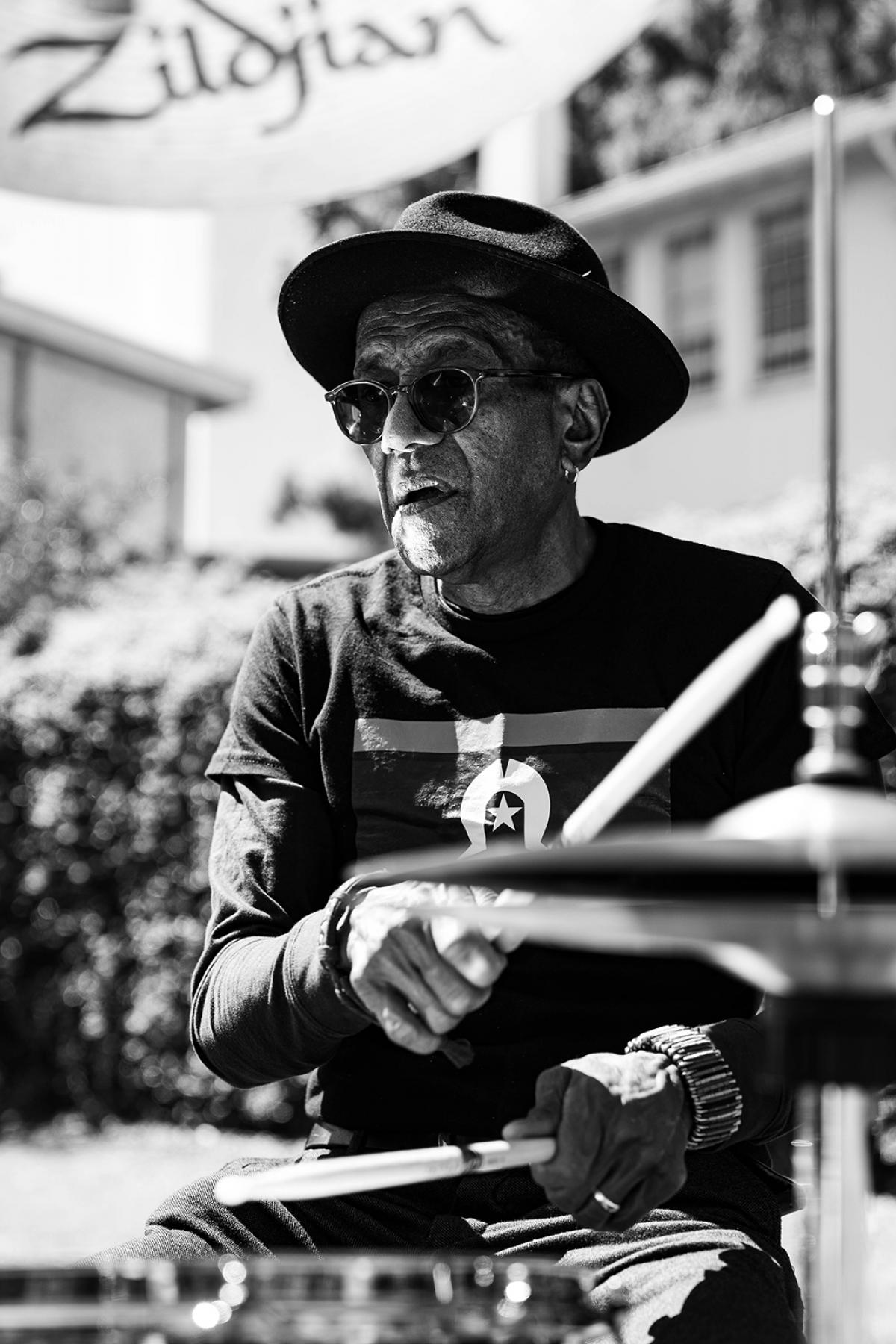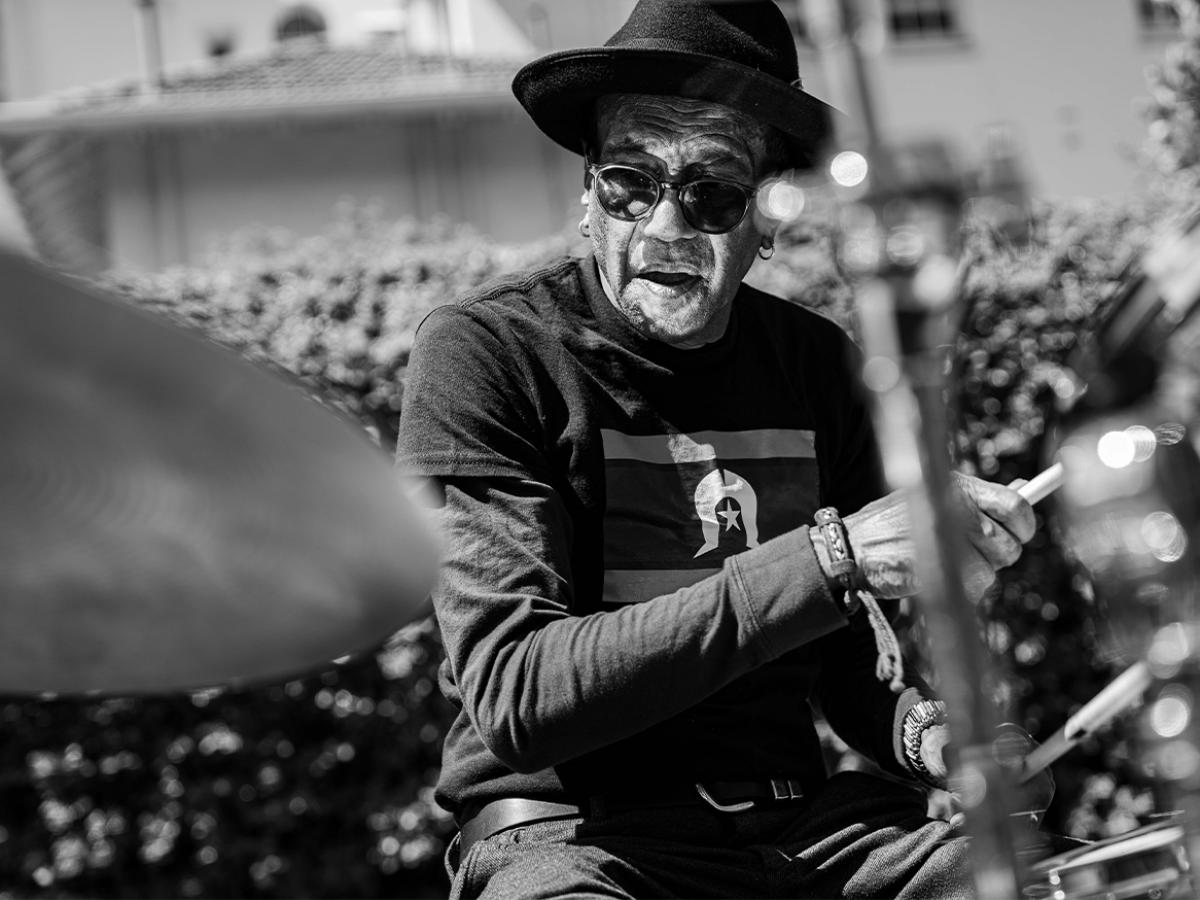Jardine Kiwat
They asked me if I could play drums because they had too many guitarists. I said yes, and then I jumped up on the kit and after rehearsals the mob said you should join CASM.

Walking through the University’s eastern gates on Frome Road in 2023 brings a familiar historical tone to my steps. I’m heading to a department where, as a student (late 1981-1984) and then staff member (1985-2008) my life changed track – the Centre for Aboriginal Studies in Music (CASM).
I first heard about CASM when I was picking grapes in the Riverland and, on a Sunday off, I met a Māori man called Milton Ruhi who had an Aboriginal friend, Randall Butler, in Adelaide where I was heading. When I contacted Randall, he said he was involved with a place called CASM and that they were looking for a guitarist for one of their bands – so I agreed to go with him.
In Adelaide, Randall took me to a soup kitchen on Pulteney Street at the back of St Paul’s Cathedral. Bands were rehearsing there, and I was introduced to the mob who told me they were studying at CASM. I was feeling shame because I could only play three chords and didn’t know what they were. They asked me if I could play drums because they had too many guitarists. I said yes, and then I jumped up on the kit and after rehearsals the mob said you should join CASM.
When the gear was pulled down and transported back to Finniss Street (then the North Adelaide home to CASM), they took me with them. They introduced me to a very tall, well-dressed African man called Ben Yengi, the Administrator of CASM, and he introduced me to the Chairperson of CASM, Auntie Leila Rankine, who gave me the biggest hug and made me feel completely at home and welcome.
Auntie Leila explained the history behind CASM and what they were striving to achieve through educating Indigenous musicians within their communities to help reduce incarceration of Aboriginal youth in South Australia. Needless to say, I signed the papers and started as a full-time student in 1982. I had a close relationship with Auntie Leila, and she saw leadership qualities in me well before I did. I became a member of the Adelaide University Student Union and was also elected to a student position on the CASM Committee.
During the earlier part of my study, while learning Pitjantjatjara language and songs with senior elder Minyingu Baker, it made me refocus on my Torres Strait Islander (TSI) language, songs and creations. I was the first Torres Strait Islander to be a student at CASM. CASM was predominately South Australian Nungas within the course then, but through word of mouth (bush telegraph), Indigenous musicians from across Australia started to arrive on its doorstep.
I started a children’s program with my nephew Getano Bann (Tudtu Children’s Theatre) to retain culture and take this to perform in schools to educate and earn extra dollars. CASM played a critical role at these times and was the central point for contacts and people working within the wider Aboriginal community and also the music industry.

I strongly believe the CASM program has produced excellent indigenous musicians and educators from across Australia
CASM attracted great interest from within the music industry and the Finniss Street location was a hive of activity for bands of all descriptions looking for Aboriginal musicians to fill in on gigs/tours or become full time members. The bands that were formed at CASM during this time were incredibly creative thanks to the diversity of musicians from across Australia.
CASM launched the movie Wrong Side of the Road in late 1981 which featured CASM bands, No Fixed Address and Us Mob as they faced racism across venues in metropolitan Adelaide and regional areas. There were scenes in the movie highlighting racism and social problems within South Australia, and the urgent need to build programs like CASM to enhance and support Aboriginal youth from incarceration through music and education.
In 1985, CASM received funding from the National Employment Scheme for Aboriginals (NESA) which allowed it to employ three graduates to undergo teaching training for three positions (studio engineer, drums and flute). I was one of them, and began training as a drum teacher under CASM lecturer Ron Nicholls. It was a very steep learning curve, helped by my experience during my student years as a drum teacher for Aboriginal youth at Warriapendi School on South Road, a school for disadvantaged Aboriginal youth who had fallen out of the system.
CASM also gave me and others a chance to travel, including to the Urban Corroboree project at the South Pacific Festival of Arts in Tahiti in 1985. Later the same year I was asked to play with Papunya band Warumpi on the 10th Anniversary of Independance for Papua New Guinea tour.
Somewhere between all of this, my commitment to my teaching, meetings, boards, panels and mentoring still had to be maintained at a high standard to honour my commitment to the CASM program.
I strongly believe the CASM program has produced excellent Indigenous musicians and educators from across Australia. CASM provided me with the opportunity to become the person, musician and educator that I am today.
Lifelong skills are gathered over time with the encouragement and guidance of Elders and personal dedication from within yourself. CASM – the best door I’ve ever walked through. Mulapa.
Jardine Kiwat was a student, graduate, teacher and mentor at CASM from 1981 until 2008. He returned as a cultural mentor in 2023 for CASM’s 50th year. The main image, by Isaac Freeman, is of Jardine playing his drums on campus near the Hartley Building on Kintore Avenue which once housed CASM.
